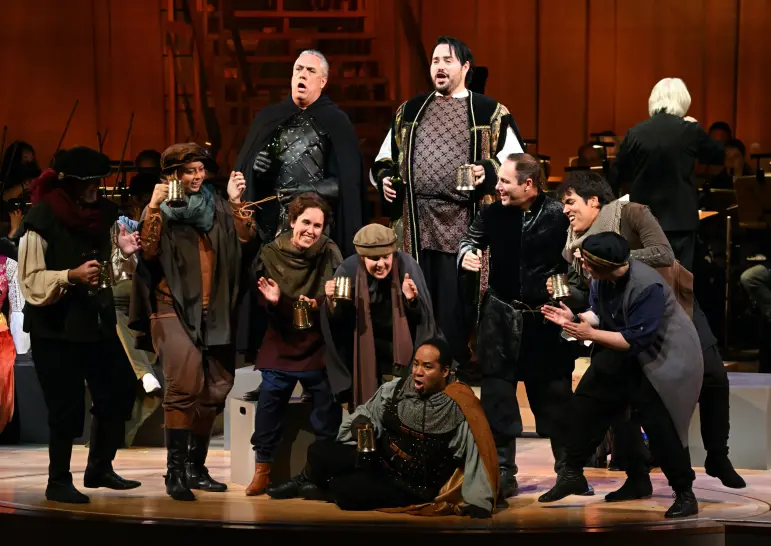REVIEW: Pacific Symphony Mounts a Surefire Production of Verdi’s ‘Otello’

This review was originally written by Timothy Mangan, a contributing writer for Arts & Culture at Voice of OC.
It was time once again for the Pacific Symphony’s annual opera performance, Thursday night in Segerstrom Concert Hall. This was the 10th anniversary of the orchestra’s opera initiative, undertaken (in part) to fill a need for grand opera in Orange County after the closing of Opera Pacific. Thursday’s effort (scheduled for repeat Saturday and Tuesday) was ambitiously devoted to Verdi’s penultimate opera, “Otello.”
As with past productions, this one was semi-staged. The orchestra is placed onstage and the action and singing unwind mostly in front of it, with minimal sets, but in costume. Conductor Carl St.Clair, in keeping with the plan, always chooses operas that have an integral role for the orchestra, not just accompaniment.

In his director’s note, Robert Neu (who worked with the orchestra previously in “The Magic Flute” and “La Traviata”) indicated he took a less-is-more approach with “Otello.” “There are times that a director needs to get out of the way and completely trust the material,” he wrote. Wise man.
Based closely on Shakespeare’s “Othello,” Verdi’s opera seemed to take on new relevance here, though not necessarily because of the production. “Othello” is a story about the destructive power of jealousy (you will remember), but here there was another layer of meaning in it. The ensign Iago instills jealousy in Otello for his faithful wife Desdemona with the use of fake news, even going so far as to stage fraudulent scenes in front of Otello. Iago’s fake news eventually leads to where fake news often does: violence and murder.
Not that Neu or anyone brought this out, or should have. It was just there for the viewer’s taking, as such things often are in old masterpieces.
As promised, Neu kept his apparent contributions to a minimum, moving the singers efficiently around the stage among simple wooden block forms. The costumes by Katie Wilson quietly put us in the mood of the Renaissance era.
This helped put the emphasis squarely on the music itself. It’s luxury casting to have a full symphony orchestra play this music and St.Clair and the Pacific musicians sounded ready for it. The opening storm scene revealed the group in fine form, rich and luxuriant in the strings, warm and clear in the woodwinds, the brass in easy balance. The orchestra performed without the usual risers and it sounds better on this stage, both more blended and lucid.
Positioned in the loft above the orchestra, the recently Grammy-winning Pacific Chorale gave a fit and trim account of the extensive parts for chorus. St.Clair led a steady and considered reading of the score, keeping the large forces easily together (the opening storm scene made its usual impression) and not forcing expressive issues. An occasional lack of Italianate style mattered little.
Tenor Carl Tanner, veteran of Opera Pacific and of this role at the Metropolitan Opera under Gustavo Dudamel, gave a commanding portrayal of the title character. Its strenuous vocal demands, high, low, loud, soft and lots of it, were met with relentless verve and power. His tone remained firm and focussed, despite fortissimo demands. It was a confident performance, through and through.

Baritone Stephen Powell clearly enjoyed singing Iago, not with a villainous twirling of mustaches or overplaying, but by savoring the words and phrases as if they were evil chocolate morsels. And he stood toe to toe with Tanner in their duets.
Making her debut in the role, soprano Kelebogile Besong provided a fragile and vulnerable account of the doomed Desdemona. Her tones shimmered, her phrases filigreed. An occasional unevenness in color and a tendency not to start notes squarely on pitch should disappear when she settles into the part.
Ironically, Otello was played by a white singer (Tanner) and Desdemona, a white woman in the Shakespeare play, was played by a Black singer (Besong). This is not that unusual in opera these days.
Margaret Lattimore (Emilia), Norman Shankle (Cassio), and Eric Barry (Roderigo) were proficient in their smaller, crucial roles. The Southern California Children’s Chorus made a crisp contribution.
Finally, a couple of purely personal observations. The average operagoing Italian of the 19th century must have loved protracted death scenes, such as in “Otello.” They no longer play so well, especially on a weeknight after a long day at work. Some judicious cutting (sacrilege!) would help many of them.
The Pacific Symphony is to be commended for presenting an opera a year in semi-staged productions this last decade. But now that it is clear that Opera Pacific will never come back, or that any other company comparable in size will be established, it is time for the orchestra to consider performing fully-staged opera, in the original Segerstrom Hall, once a year. Difficult? Yes. Unfeasible? No. Where there’s a will there’s a way.

Yes, please (Segerstrom Hall) , and yes, thank you! (for the suggestion).As a season subscriber to Opera Pacific, which staged operas in the former movie theater on the northeast corner of Bristol and Town Center Dr., I sorely miss opera productions. RE; Pacific Symphony’s productions, the staging/performance/costumes for Die Zauberflöte was exquisite!
It would indeed be sacrilege to cut even a single note of the final scene. In Shakespeare’s “Othello” the same scene is *much* longer. Should *it* be shortened as well? Verdi and Boito, with their characteristic economy, reduced it to its essential material, precisely with the intention to move the action forward. Perhaps, rather than cater to our 21-st century shortened attention spans, when we can use the TV remote control to fast-forward through the boring bits and commercials, going to the symphony and the opera can give us a welcome respite and allow us to slow down and savor the unfolding of the drama.